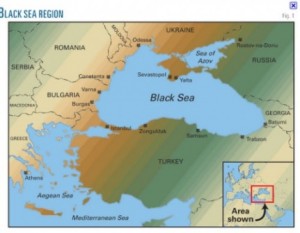Giovanni Pallotta in Bucharest
 With the southern area of Eastern Europe causing worry and trepidation for many Chancellor’s offices around the world, and the whispering of so-called political encounters and negotiations (both public and private) have not helped to ease tensions, USA and its Allied war machine are heating up its motors.
With the southern area of Eastern Europe causing worry and trepidation for many Chancellor’s offices around the world, and the whispering of so-called political encounters and negotiations (both public and private) have not helped to ease tensions, USA and its Allied war machine are heating up its motors.
If worldwide opinion is fully aware of Russia’s military exercises causing worry and fears, the manoeuvres and exercises by the Allied forces are a well-kept secret. Since the middle of March, in the areas situated near Ukraine, military and air force exercises has been regularly conducted by American, Romanian, Polish and Bulgarian military forces.
The first important military exercise took place in the Black Sea area on March 12th and involved the destroyer USS Truxtun, the warship Queen Mary, escorted by Romanian corvettes, Vice Admiral Eugeiu Rosca and Second Admiral Eustatiu Sebastian, and by the Bulgarian battleship Darzki.
This line-up may appear modest, if we take into consideration the forces that Russia can count upon in its naval base in Sebastopol; where Russia boasts a submarine, a cruiser, two destroyers, two battleships and an air float of 22 Sukhoi 24M and the famous Soviet Sukhoi 24 attack aircraft.
Regardless of this fact, the presence of four naval units from three different nations has evoked upsetting feelings for various reasons. First of all, the Romanian naval base of Constanta, situated 220 nautical miles from Sebastopol has become the departure port of operations. Furthermore and above all, the presence of a task force which includes the American air-craft carrier, George Bush, escorted by destroyers, Roosevelt and Philippine Sea, with 1700 marines and 90 Hornet and Superhornet all placed near the River Bosforo has evoked tension and worries.
Taking into consideration all these factors, one can understand the feelings of extreme anxiety and worry in Russian military and information sectors. These feelings can be summarized in the English foreign affairs journal Russian Global Affairs Director, Mr Fyodor Lukyaov. In a statement to Reuters, Mr Lukyav affirmed that concerning American provocations, Mr Putin has every reason to be concerned about the Russian float in Sebastopol.
The exercises terminated at the end of March, however the tense situation in the Black Sea area has not been placated. On Sunday, April 13th, Romanian President, Mr Traian Basescu, visited the American destroyer, Donald Cook (which had been patrolling Romanian waters in the Black Sea since April 1st) and declared that he and his country opposed Putin’s political stance. During his visit on board, a Russian attack aircraft, the Sukhoi 24M, circled twelve times at a low altitude causing tension to the personnel on board while counter measures in case of an air raid were activated. Subsequently, this act was condemned harshly by the Pentagon that defined the action as a provocation without precedence and against all military protocol.
If the Black Sea area has been a hot spot during these last few weeks, the situation in the Eastern European skies is not much better. Meanwhile, during the last two weeks of March, American and Polish aviation have been carrying out joint operation actions. If, at the beginning of the crisis in the Crimean area joint operations had been foreseen only for the bombers, the Polish command has now asked for twelve F16s to be sent over. These aircrafts are not only able to respond to air fire, but they can also be used as fighter-bombers and reconnaissance aircraft. Simultaneously, with the end of the operations, the Commander of the American Air Force in Europe has received orders to set up patrols along the borders of Polish, Romanian and Ukrainian air space using planes equipped with Airborne Warning and Control Systems. The decision was confirmed by US Defense Secretary Chuck Hagel during a press conference on 18th April.
The picture that is emerging seems to be quite evident. Some NATO nations and the United States are gearing up to react to whatever scenario may appear on the horizon. On one hand, diplomacy is being used, thus taking on the role of Protectorate of regional order, while on the other the forces are getting ready to show Moscow that in case the stakes get higher, they are ready to take counter measures regarding the whole area and in a very vast arena. In this “match”, Washington will be aided by its Eastern European allies, in particular Romania and Poland that have realized that they will have the opportunity to play an active role as real regional powers. It is important to remember that the Romanian authorities, in particular, are pressuring the American military forces to maintain a stable and constant presence of NATO forces in Romania, in particular it is important to consider the political efforts made by the former Romanian minister of Foreign Affairs, Mircea Geoana (he was minister in 2004 when Romania joined the NATO).
This pressure received tangible results on March 27th when the American government formally pointed out the need to reinforce American presence in the Air Force base of Kogalniceanu near Constanta. By the end of April, 1600 Marines airborne trained will be sent to the Romanian military base. With this increase of this contingent, an increase in logistic support, particularly, amphibious operation ships are also foreseen. These are all signs that let the reader understand that the game in Eastern Europe is still a long way from being over.
Giovanni Pallotta
See also:
Operativo in Romania l’hub di ingresso e uscita dall’Afghanistan per i militari americani. Sostituisce Manas in Kirgizistan (4 marzo 2014)
Photo credits novinite.com




